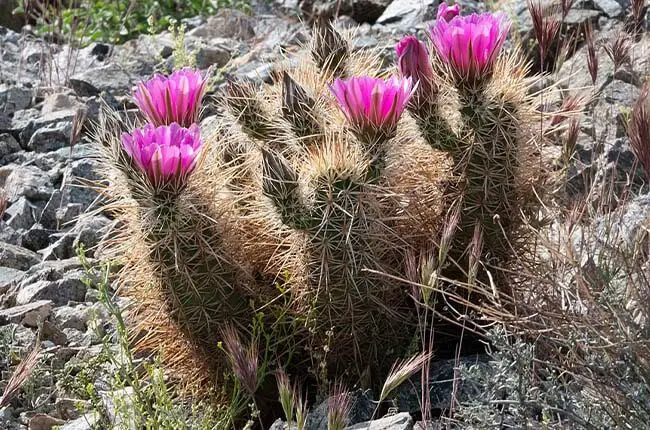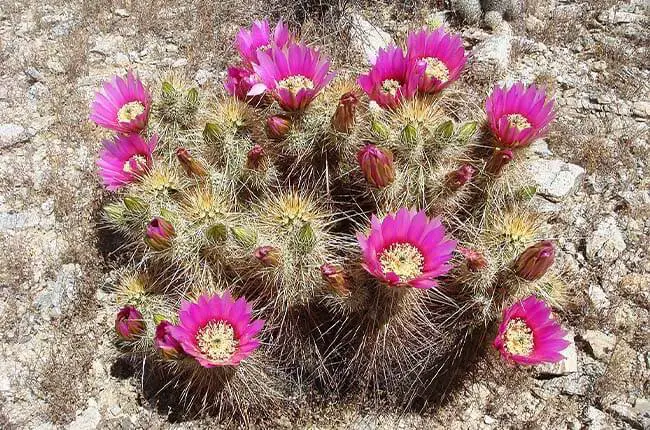Echinopsis and echinocereus are some of the favorites of most cactus lovers. They both have gigantic, and intensely bright-colored flowers, and they can both be very small or grow to tree-like sizes.
But the major difference is that Echinopsis have round, globose bodies with short spikes that are often short or even turned inward giving it a fuzzy look, with flowers resembling Easter lilies. In contrast, Echinocereus have long cylindrical bodies with long spikes resembling a porcupine.
In this article we will show you the differences between these two easily confused genera of cactus.
Differences between Echinopsis and Echinocereus
Both echinopsis and echinocereus cacti thrive indoors and outdoors under the right conditions. Both species vary widely in appearance and shape, ranging from the small, button-like cacti you see lining windowsills in small terracotta pots to the enormous, tree-like behemoths sprouting from the desert sand.
Both genera have over 100 different species in each, making them difficult to identify. Below, we dive into the specific ways to identify each.
1. Appearance
Echinopsis
The name echinopsis comes from the Greek word echninos – which means “spiny” – and opsis, which means “appearance.”
True to its name, echinopsis species are spiny with large, brightly colored flowers. Echinopsis are commonly called “hedgehog cacti,” “sea-urchin cacti,” or “Easter lily cacti” (due to the white flowers that many species possess and somewhat resemble Easter lilies).
All the cacti belonging to the echinopsis genus have rounded, globose bodies and sharp spines that may be turned outward – in the characteristic needle shapes so synonymous with cacti – or curved inwards towards the grooves in the cactus’s body, making the plant appear fuzzy or wooly.
Echinopsis species can be globose, shrubby, treelike, cylindrical, pendant, or any combination. In general, echinopsis species are globose, spiny, and ribbed. Due to their showy appearances, they are popular for hobbyists and gardeners.

(Mats Winberg, CC BY-SA 2.5, via Wikimedia Commons)
Echinocereus
The name echinocereus comes from the Greek words “echinos” – meaning “porcupine” – and “cereus,” meaning “wax candle”, referring to their long cylindrical bodies with long, stiff spikes resembling a porcupine.
Echninocereus cacti can be small to medium size, as short as 1 cm (0.4 inch) in height or as tall as 60 cm (24 inches).
They often grow in clusters.

(Kyle Nessen, CC0, via Wikimedia Commons)
2. Flower
Echinopsis
The large, bright flowers of echinopsis cacti are funnel shaped with scaly floral tubes covered with fine, sticky hairs. The blossoms themselves last only a day or two before wilting and falling off, quickly transforming into fruit with the same hairy appearance and soft insides.
Echinopsis cacti all have showy, beautiful flowers, the colors of which range from white, yellow, orange, pink, orange, and red – some even have a combination of the two. It isn’t uncommon for two cacti of the same species to have different colors. One of the most remarkable features of echinopsis flowers is that they are borne upon short, squat stems.
Most echinopsis flowers have sweet scents and thin, papery petals.
Echinocereus
The brightly colored flowers of the echinocereus genus are funnel-shaped and grow upright, in the same direction as the tubercles.
The fruit is either round or oval in shape and usually has black seeds.
3. Origin
Echinocereus are native to North and Central America and can tolerate very cold temperatures, unlike echinopsis which can only tolerate the hot temperatures of South America.
Echinopsis
All species within the echinopsis genus are native to South America, with most concentrated throughout Argentina and Bolivia. However, many popular species are cultivated throughout the world for commercial sale.
Echinopsis species need full light to thrive fully, ideal with southern exposure during the winter months. During the summer months, however, make sure not to have too much direct light since the cactus can burn and wither.
Like most cacti, echinopsis don’t need much water. Plant in fast-draining soil (sandy, rocky soil is best because it doesn’t retain moisture) and add cactus fertilizer for healthy growth. Let the soil dry out almost completely between thorough waterings.
Echinocereus
Echinocereus are native to North and Central America. They thrive throughout northern Mexico, such as Chihuahua and the Sonoran Desert, as well as the southwestern United States such as Arizona, New Mexico, Colorado, Utah, Texas, and southern California.
Echinocereus grow in sunny, dry conditions and are surprisingly hardy in cold temperatures, so they can survive in temperatures as low as 9 degrees Fahrenheit (-23 degrees Celsius) on dry days.
In cold temperatures, any humidity is damaging to the cactus. Some humidity is fine during the summer, especially when there is plenty of drainage.
4. Classification
Echinopsis
There are 128 species within the genus of echinopsis. Some of them are rare such as the echinopsis angelesii; but others are commonly found in growers’ markets such as echinopsis eyriesii (also known as the Pink and Red Easter Lily Cactus).
Popular Echinopsis Species
- Echinopsis ancistrophora – also known as Echinopsis subdenudata. This is a small, barrel-shaped cactus with white, yellow, orange, or red flowers, great for planting in pots.
- Echinopsis angelesii – shrubby cacti with white flowers and curved tubercles that grow upwards. Native to Argentina, this species is quite rare.
- Echinopsis atacamensis – this large, treelike species is one of the larger variations and is native to both Bolivia and Argentina. Can be found growing along cliffs and other non-flat surfaces. Has sharp, needle-like spines that stick straight out and white flowers.
- Echinopsis arboricola – this interesting species has long, draping tubercles that are commonly seen growing from a hanging planter. When growing from the ground, the tubercles are winding, curved, and meandering. The plant has white flowers.
- Echinopsis ferox – a globose species with bright pink flowers and long, hairy spines that resemble a layer of grayish fuzz on the outside of the cactus.
- Echinopsis famatimensis – also known as the Orange Cob Cactus, this cactus has very small spines and smooth, globose bodies that grow in clusters. Its bright yellow flowers are what give this cactus its common name.

(Juniperbushman, CC BY-SA 3.0, via Wikimedia Commons)
Echinocereus
Echinocereus includes 70 species native to Mexico and the southern United States.
Popular Echinocereus Species
- Echinocereus stramineus – this cactus has long, light brown spines and is commonly known as the straw-colored hedgehog.
- Echinocereus rigidissimus – this rare cactus species is also known as the Arizona Rainbow Hedgehog Cactus or the Sonoran Rainbow Cactus due to its bright pink and red flowers and its colorful purple spines. As its common names suggest, this rare cactus is native to the Sonoran Desert in Chihuahua, Mexico and Arizona, as well as New Mexico.
- Echinocereus engelmannii – with its purple and red flowers, this medium-sized cactus goes by many names, including but not limited to the Calico Cactus, the Strawberry Hedgehog Cactus, and the Dagger-Spine Hedgehog.
- Echinocereus coccineus – this cactus grows in clusters and has orange and yellow flowers. It grows as far north as Colorado and Utah in the US.
- Echinocereus triglochidiatus – this cactus is best known for its bright red flowers and is also called the claret cup, the kingcup, and the scarlet hedgehog cactus.
- Echinocereus berlandieri – with pink, purple, and red flowers, this cactus is native to Texas and Tamaulipas, Mexico.

(Miwasatoshi, CC BY-SA 4.0, via Wikimedia Commons)
Final thoughts
Although they both look spiny with showy colorful blooms, echinopsis cacti have a rounded body shape and are more tolerant of hot temperatures. On the other hand, echinocereus cacti have a cylindrical shape with long spines like a porcupine and are more tolerant of cold temperatures.
Happy gardening!
Related
Top 14 Variegated Cacti (With Pictures)
13 Cacti By Flower Color (With Pictures)
4 Ways To Determine The Age Of Cactus
- Top 6 Drip Irrigation Systems for Raised Beds (2025) - January 31, 2025
- Top 10 Orchid Fertilizers: A Comprehensive Review (2025) - January 16, 2025
- Top 6 Slow-Release Fertilizers for Houseplants & Veggies (2025) - January 15, 2025

